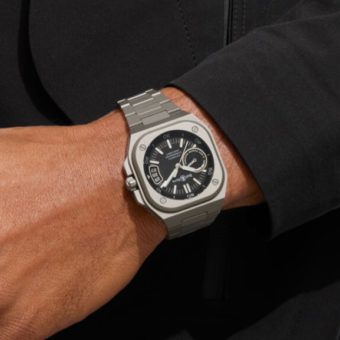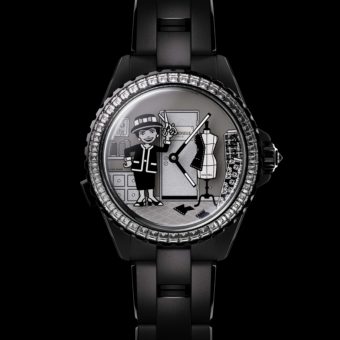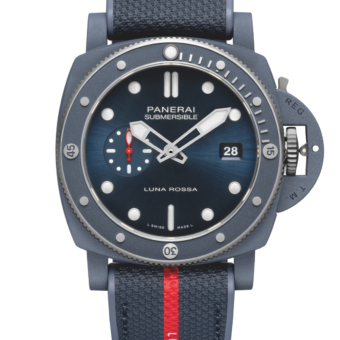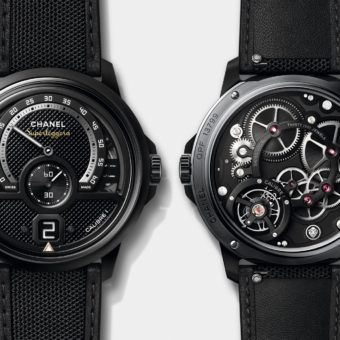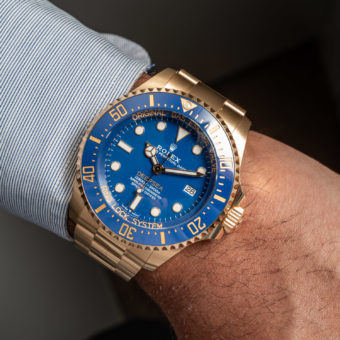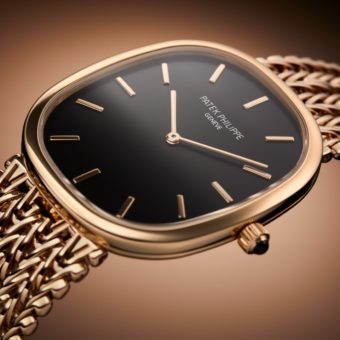As legions of Paneristi are aware, Officine Panerai has had a long association with the sea; the brand was, after all, established as a supplier of professional diving watches to the Italian Navy. More than a decade ago, the Florence-born, Swiss-made Panerai brand built on this maritime legacy by sponsoring the Panerai Classic Yachts Challenge, an international series of regattas in which vintage boats in several classes compete for a prize Panerai timepiece. This year, I had the honor of joining Panerai for the first North American leg of the PCYC, at the Corinthian Classic Yacht Regatta in Marblehead, Massachusetts. Even better, I had the companionship of a new-for-2015 Panerai watch for this weekend on the waves: the Panerai Luminor 1950 3 Days Chrono Flyback Automatic Ceramica (44 mm).
Launched at SIHH 2015, the watch (reference number: PAM 00580) is distinguished by its 44-mm-diameter matte-black case, constructed of a synthetic ceramic based on zirconium oxide. This high-tech case material is up to five times harder than steel but substantially lighter in weight, as well as highly resistant to scratches, corrosion and extreme temperatures. Upon first strapping on the Ceramica — which comes on a sporty, natural brown leather strap with contrast stitching and a case-matching, black-coated titanium buckle — you’ll notice its undeniably big and masculine proportions. However, the use of ceramic for the case, and the supple softness of the strap, makes it extra light and comfy on the wrist — an important factor when you’re going to be wearing it for several days in the scorching August sunshine.


Like other Panerai models with the classical Luminor 1950 case, this one is equipped with the Panerai-patented crown protector, whose tiny locking lever can be engaged and disengaged with a flip of the thumb or forefinger. Locking and unlocking the device — which one does in order to set the watch’s time and date and wind its mainspring — provides a bit of tactile fun while adding to the timepiece’s “tool watch” appeal. It’s almost a shame that, thanks to the Ceramica’s three-day power reserve, you don’t really need to perform this operation all that often (More on this later).
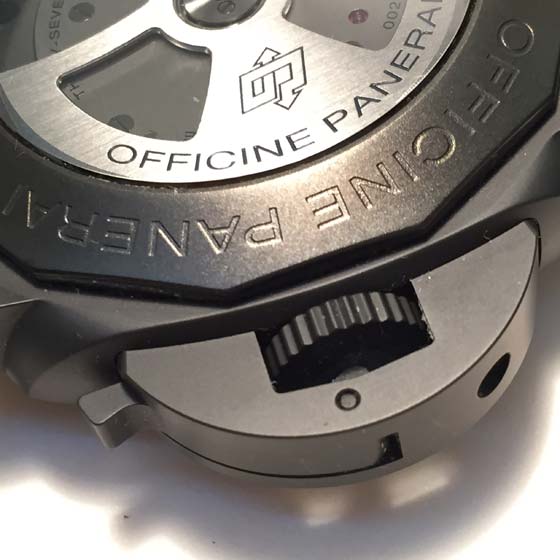
As its lengthy moniker makes clear, the watch’s showcase function is a flyback chronograph, and a somewhat unconventional one at that (No, it’s not a regatta countdown timer; that would be the PAM00526 model). To preserve the aesthetic purity of the Luminor 1950 case, the two chronograph pushers — which in most such watches would flank the winding crown on the right side of the case — were placed on the left side, where they would not be in the way of the crown protector. Another clever design choice is the use of two center-mounted hands — a blued hand to count the stopwatch seconds and a rhodium-plated hand to tally the accumulated minutes. As these hands contrast nicely both with each other and with the matte-black dial, an easily legible reading of the chronograph is assured. (The one subdial, at 9 o’clock, is for the continuously running seconds.) Pressing the pusher at 10 o’clock starts and stops the chronograph, while pressing the one at 8 o’clock sends the Panerai-blue seconds-counter hand flying back to zero and also resets both central hands at the end of timing an interval.

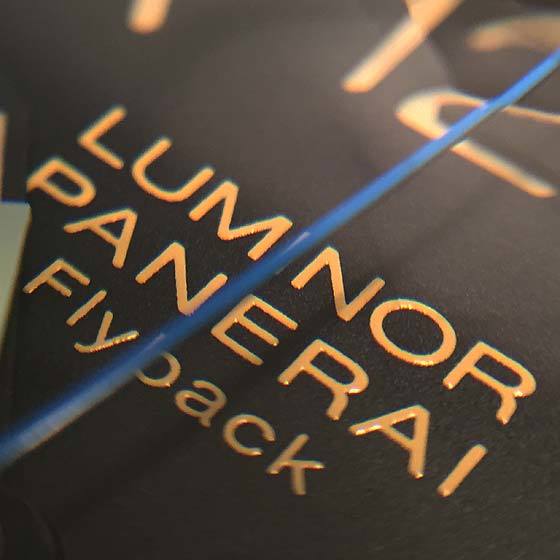
One might think this unorthodox positioning of the chrono pushers would make them more unwieldy to operate (at least for a right-handed person wearing the watch on his left wrist) but the opposite is true. While the pushers are somewhat small, and require a rather firm touch to engage, this design means you can get some leverage and apply a little extra force by grasping the opposite corner of the case with the thumb and and using the forefinger to press the buttons.
The watch was put through its paces during the two days of the Corinthian Yacht Club Regatta, during which I joined a small group of Panerai guests on a well-appointed and professionally captained spectator boat to follow the great, vintage sailing vessels in their quest for trophies. Setting off from the Marblehead harbor, we traced the route taken by the yachts, out to Newcomb’s Ledge, around Baker’s Island, and back to the finish line near our “home base,” the chic Corinthian Yacht Club. Day one of the regatta was sunny and breezy, and while the captains and sailors aboard the competing yachts certainly put forth their best efforts, my crew on the motorized spectator boat — with fully stocked bar, boxed lunches, and even resting quarters below decks for anyone who felt seasick — had a relatively laid-back day. Day two, on the other hand, which started off with ominous cloud cover, whipping winds and choppy waters right from the starting gun, was more like a Herman Melville adventure.

As we strove to keep pace with the racing yachts — a few of which actually retired from the race due to the windy conditions, lest you think I am exaggerating for effect — my small group of colleagues on the spectator boat (which included Panerai U.S. brand president Rafael Alvarez as well as associates from the non-profit charitable organization Sailing Heals, a Panerai partner that takes cancer patients and their caregivers for sails on yachts) were tossed about and at some points drenched by the swelling waters. It even occurred to me — since the Panerai I was wearing is an automatic watch, and my limbs were moving around above and beyond the usual lazy Sunday activity just to maintain balance — that the watch might actually become overwound or suffer other adverse effects, but those fears proved groundless. The timekeeping remained top-notch both during and after the rough day on the regatta circuit. The Incabloc shock protector in the movement certainly contributed to this robust performance, and, of course, the locked, water-resistant case lived up to its billing as well. Drinks were spilled, ballcaps went flying, the navigational charts needed to be secured with makeshift paperweights, but no one got sick — and the whipping Panerai flag remained stoutly standing on the boat’s bow.

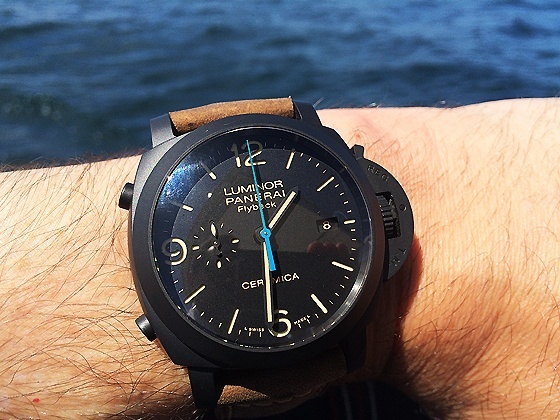
Locked securely inside the sleek black case of the Luminor 1950 Chrono Flyback Ceramica is Panerai’s Caliber P.9100, which boasts two technical features beloved by chronograph geeks: a column-wheel switching mechanism and a vertical clutch. Twin spring barrels connected in series account for the three-day power reserve touted in the model’s name, and the variable inertia balance wheel oscillates at a speedy 28,800 vph, or 4 Hz. At first glance, it appears as if the caliber has a gray or black finish, but this effect is actually due to the smoke-tinted sapphire viewing window in the caseback, a nice touch that adds to the watch’s “stealth” look. And while I am admittedly a bigger fan of Panerai’s manual-wind movements when it comes to aesthetics — with the huge, tectonic-looking plates and very masculine lack of ornamentation — I do enjoy the convenience of automatic winding, especially when it comes with a three-day power reserve. (Incidentally, a few days after the regatta weekend, I was reminded how a watch with a three-day power reserve can bestow peace of mind when one is rushing around to get ready in the morning and realizes he hasn’t worn the watch for a day or two. Just as I was prepared to devote a few precious moments to resetting and manually winding it, I noticed that the time and date on the dial of the Ceramica matched up more or less precisely with those on my iPhone. Win!)
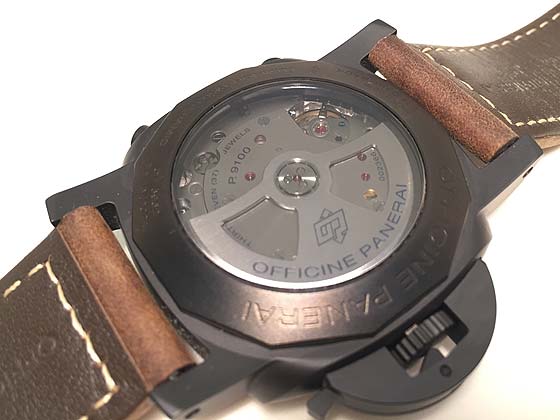

The black “sandwich” dial, another Panerai hallmark, has suitably large Arabic numerals and indices that make the watch eminently readable in all conditions — not to mention, as with most Panerai watches, recognizable from across the room (albeit also notoriously difficult to photograph under sunlight, as you may note). A nice discovery I made during the evening of the regatta’s second day was how strongly and sharply its numerals, indices, and hands glowed after the layer of Super-LumiNova under the main dial (the “meat” in the “sandwich,” I guess, for lack of a better metaphor) spent a full day of soaking up the sun while we were out on the water. One could almost set the watch on its side on a nightstand or dresser and use it as a nightlight.
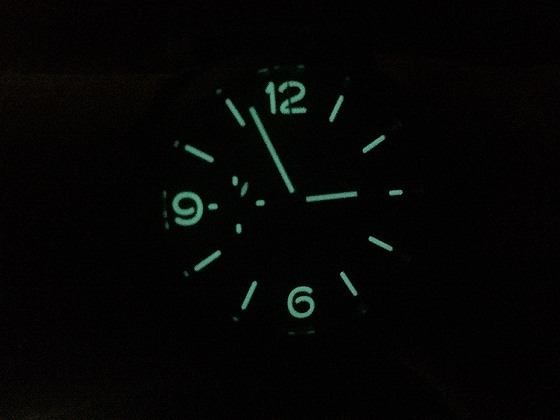
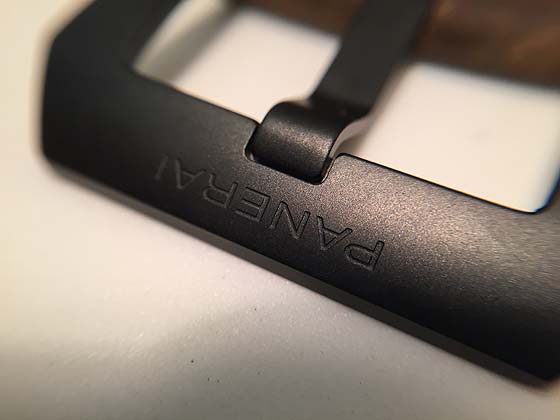
So who claimed the Panerai Prize in this year’s Corinthian Classic? While some of us from the tempest-tossed spectator boat were still swaying on our feet at the prize-giving ceremony at the Corinthian Yacht Club, a sure-footed Alvarez presented a brand-new Panerai Radiomir 1940 3 Days Acciaio 47 mm to the captain and crew of Neith, a 1907 sloop designed as a “weekender yacht” by Captain Nat G. Herreshoff and making its return to regatta racing after a two-year makeover. Interestingly, the Neith was one of the competitors we on the spectator boat had taken early notice of, with its crew outfitted in hard-to-miss black-and-white nautical-striped uniforms.
The Panerai Classic Yachts Challenge continued in Nantucket the following weekend for the Opera House Cup Regatta, and concludes its North American circuit on September 5th and 6th at the Museum of Yachting Classic Yacht Regatta in Newport, Rhode Island. My wrist companion for the Marblehead experience has, sadly, sailed back to Panerai HQ, but perhaps we’ll meet again — somewhere beyond the sea. Price: $16,300.

